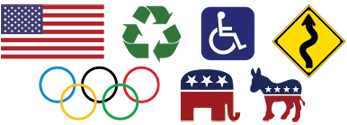Video: The Power of Visual Symbols
Wikipedia: List of Symbols
Web site: The Noun Project - Icons for Everything
Web site: Graphic Design History - The History of Symbols
Web site: Ancient Symbols
Web page: 24 Cool Logos with Hidden Symbols
From the time of Stone Age cave paintings to the present, symbols have served as a powerful means of communication. Symbols bring a lot to mind. They can represent ideas and beliefs; give commands and warnings; sell products and ideas; evoke thoughts and feelings. Visual symbols are all around us, and we are constantly interacting with and interpreting them.
Like reading words, you must “read” symbols in order to derive their meaning, both denotative and connotative. Denotative meaning is the more immediate surface meaning. For example, the American flag uses 50 stars to represent the 50 states and 13 stripes to represent the 13 original colonies.
But symbols also hold connotative, or secondary, meaning. This meaning stems from the personal associations you may have with a symbol, based on your unique experience, beliefs, and culture. For some people, the American flag may evoke thoughts of freedom, democracy, patriotism, and opportunity—ideas connotative of their particular experience.

Your Turn Which of the symbols shown above are familiar to you? List their denotative meanings. Then choose one of the above symbols (or some other symbol) and analyze it by asking the questions given on this page. Report your findings in a paragraph or short essay.
Video: The Power of Visual Symbols
Wikipedia: List of Symbols
Web site: The Noun Project - Icons for Everything
Web site: Graphic Design History - The History of Symbols
Web site: Ancient Symbols
Web page: 24 Cool Logos with Hidden Symbols
© 2014 Thoughtful Learning
